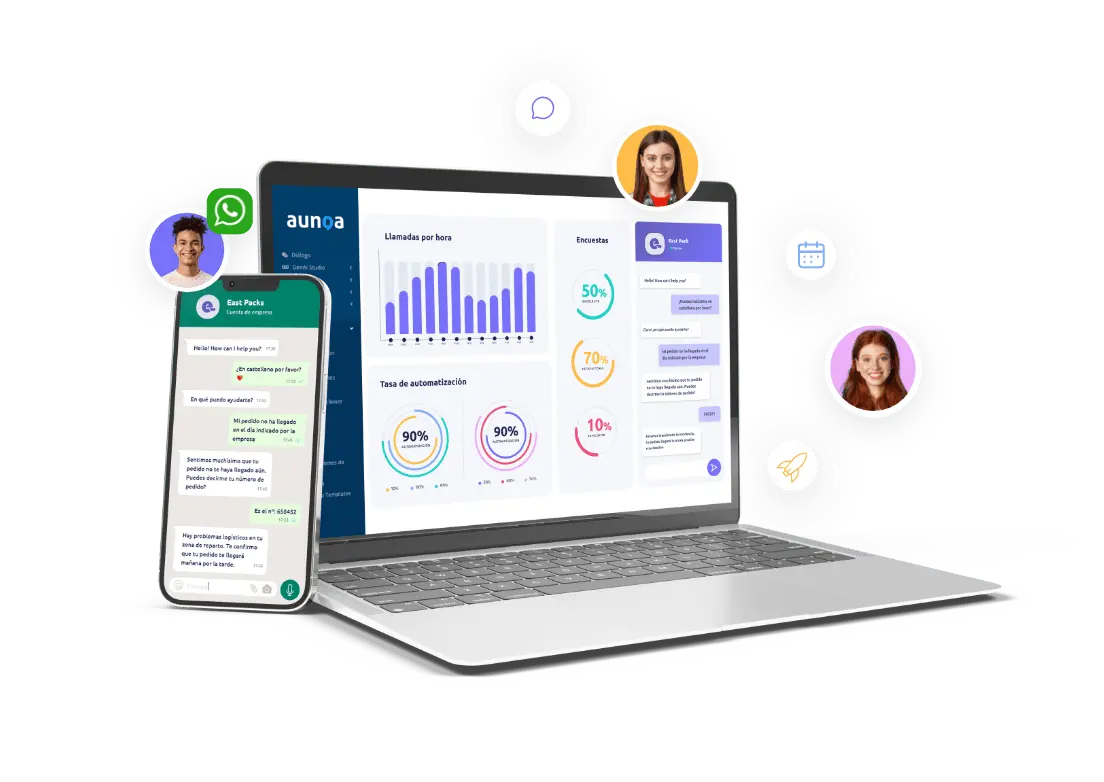In a world where consumers demand direct communication channels and immediate responses, brands must offer an effective and appropriate solution.
The high connectivity rate among Spaniards and the high mobile phone penetration rate (116 lines per 100 inhabitants) intensifies the need to be available when the consumer needs it.
Conversational Artificial Intelligence (AI), virtual assistants, and chatbots have evolved at a very rapid pace.
Many people refer to these tools using incorrect terminology. Each type of technology has particular characteristics and functions. Therefore, it is important to understand the scope of each tool to select the most suitable option for your business.
Below, we explain the differences between rule-based chatbots, virtual assistants, and AI-powered chatbots.
What is a chatbot?

A conventional chatbot, also known as a rule-based chatbot, is a program/application with which users can make inquiries about products or services, either in an online store or digital media. Its operation is simple, fulfilling basic functions in a particular context.
This mechanism responds to simple and specific pre-configured questions and, in general, they are easy to install as their capabilities are limited.
The chatbot does not have the capability to transfer queries to an agent and does not understand natural language. It also cannot capture, process, or transfer data, requiring manual work from the Customer Service department.
This type of chatbot is configured with a series of pre-set flows and messages, meaning they are programmed to respond to a limited number of queries and do not allow for continuous or prolonged human interaction.
What is a virtual assistant?
A virtual assistant is support software, either text-based or voice-based, that provides assistance to users in completing tasks.
The main advantage is that it offers a more dynamic interaction, as it can understand the user’s request, analyze emotions, and identify the language used by the user. This tool focuses on Natural Language Processing (NLP) and Natural Language Understanding (NLU).
Unlike chatbots, virtual assistants have a more sophisticated interactive platform, which allows them to respond based on what they read or hear, showing greater empathy with the user.
Virtual Assistants are also known as AI-powered chatbots. These two concepts share characteristics and have evolved to become intelligent conversational agents.
Thanks to advances in NLP and Machine Learning, AI chatbots and Virtual Assistants can perform many functions and are used in different contexts to improve communication between businesses and users.
AI-powered Chatbot
The AI-powered chatbot is a tool for interacting with users, capable of automating queries and processes, offering a personalized conversational experience.
By utilizing Artificial Intelligence, it is a much more sophisticated chatbot, designed to guide the person through accurate questions and answers to provide a concrete solution to their query. For this, it uses Natural Language Processing (NLP), voice recognition, and Speech-to-Text (STT) transcription.
Unlike a regular chatbot, AI chatbots can understand, process, and respond in the user’s language, which allows them to solve transactional and informational queries as well as complex tasks.
Additionally, they can categorize tickets and transfer queries to a specialized agent, allowing for complete control of Customer Service in real-time and connecting with various channels or management applications.
How to differentiate between a chatbot, a virtual assistant, and Artificial Intelligence?
This table summarizes the key differences between chatbots, virtual assistants, and artificial intelligence, covering aspects such as interaction, scope, autonomy, task complexity, machine learning, personalization, and providing representative examples for each category.
| Characteristic | Chatbot | Virtual Assistant | Artificial Intelligence |
|---|---|---|---|
| Interaction | Predefined responses, limited interaction | More complex conversational interaction | A set of technologies that enables automatic learning and reasoning |
| Scope | Specific to defined tasks and contexts | Can handle a variety of tasks and questions | Broad, encompassing various applications and disciplines |
| Autonomy | Pre-programmed automatic operations | Greater autonomy to perform complex tasks | Ability to learn and adapt to new situations |
| Task Complexity | Specific and routine tasks | Can perform complex and varied tasks | Handles complex problems and advanced analysis |
| Machine Learning | Depending on the design, it may or may not learn | Can learn and improve over time | Fundamental, based on machine learning and data processing |
| Personalization | Limited to initial programming | Can adapt to user preferences | Continuously adapts and improves with experience |
| Popular Examples | Customer service chatbots, FAQs | Personal assistants like Siri and Google Assistant | Recommendation systems, voice recognition, etc. |
Find the ideal solution for your client and reduce operational burden
To establish a strong and long-term relationship with customers, it is vital to create a bond of trust that is close and dynamic.
When dealing with inquiries or complaints, it is not just about providing a quick response, but one that is personalized, empathetic, and correct.
The volume of messages a company can receive daily can be overwhelming, making it necessary to implement technological solutions to optimize human resources and maintain or increase customer satisfaction.
In this context, Artificial Intelligence tools and virtual assistants have proven to be highly effective solutions in delivering personalized, immediate, and effective service, meeting customer expectations, and reducing the operational burden on the company.







